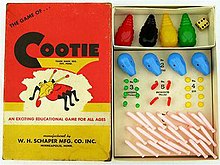 Original box cover and game components, 1949 | |
| Designers | William H. Schaper |
|---|---|
| Publishers | Hasbro |
| Publication | 1949 |
| Players | 2 to 4 |
| Setup time | 2–4 minutes |
| Playing time | 10–20 minutes |
| Chance | Entirely |
| Age range | 3 and up |
| Skills | Matching |
The Game of Cootie is a children's game for two to four players. The object is to be the first to build a three-dimensional bug-like object called a cootie. The game was invented by William H. Schaper in 1948. In 2003, the Toy Industry Association included Cootie on its "Century of Toys List" of the 100 most memorable and most creative toys of the 20th century. [1]
